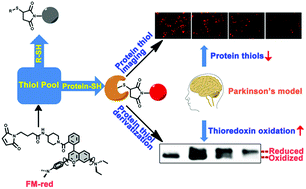Depletion of protein thiols and the accumulation of oxidized thioredoxin in Parkinsonism disclosed by a red-emitting and environment-sensitive probe†
Abstract
Protein sulfhydryl groups play a vital role in maintaining cellular redox homeostasis and protein functions and have attracted increasing interests for the selective detection of protein thiols over low-molecular-weight thiols (LMWTs). Herein, we reported a red-emitting and environment-sensitive probe (FM-red) for detecting and labeling protein thiols. The probe contains a maleimide unit as a thiol receptor and an environment-sensitive fluorophore as a sensor. The emission signal of the probe was exclusively switched on by binding to protein sulfhydryl groups through the twisted intramolecular charge transfer mechanism, while negligible fluorescence was observed when FM-red reacted with LMWTs. Various experiments verified that FM-red possessed fast responsivity (∼10 min) and high selectivity to sense protein thiols over LMWTs with a red emission (∼655 nm). These favorable properties enable the probe to image protein sulfhydryl groups in live cells and in vivo. In addition, as FM-red has a relatively high molecular weight (MW 688), it is able to separate the labeled proteins from the unlabeled ones after FM-red derivatization via routine protein electrophoresis, which may be applied to determine the redox states of thioredoxin, a small redox protein ubiquitous in all cells. With the aid of the probe, we demonstrated a significant decrease in the protein thiols and the accumulation of oxidized thioredoxin in a cellular model of Parkinson's disease.

- This article is part of the themed collection: 2019 Journal of Materials Chemistry B HOT Papers


 Please wait while we load your content...
Please wait while we load your content...